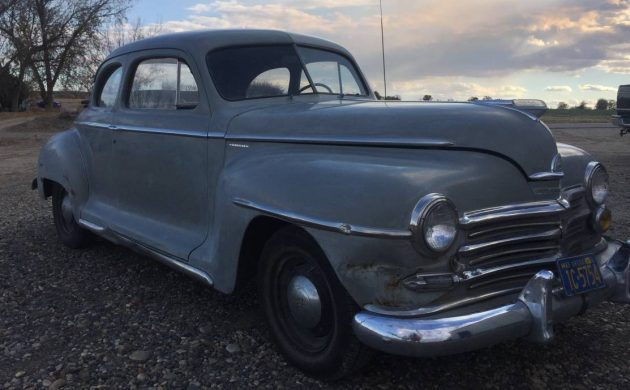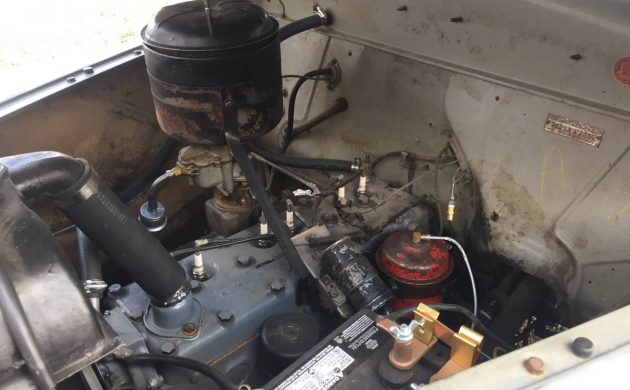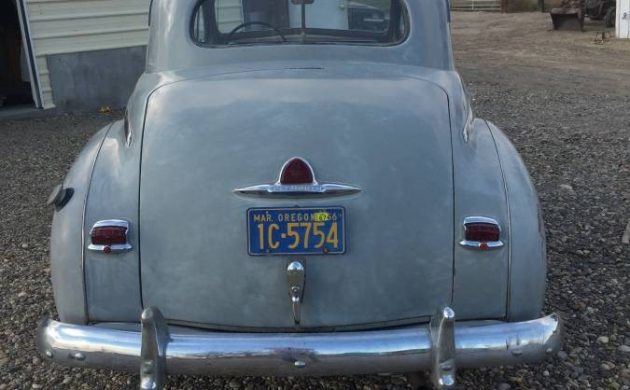This 1949 Plymouth is a two owner vehicle. The current owner has put a lot of time, and apparently, a lot of money, into the car, but has now decided to sell it. You will find the Plymouth for sale here on Craigslist. It is located in Fruitland, Idaho, and is being offered for sale with a clean title. The owner has set a sale price of $8,000 OBO for the Plymouth.
The owner doesn’t make any mention of rust issues on the Plymouth, but I must say that the body appears to be quite clean, and seems to be free of any rust or corrosion issues. There are a few dings and scrapes on the car, and this has resulted in some of the external trim items becoming damaged. While some of these may be able to be repaired, some of them do appear to be damaged beyond repair.
The interior is complete, and it really doesn’t look too bad. There is a hole in the upholstery on the driver’s seat, but it looks like there are slip-covers on the seat back, and also on the back seat. In all honesty, this is an interior that you could use as it is, or it does appear to be a nice, solid base for a restoration.
Apart from a solid body, the majority of the good news about this car revolves around the mechanical components. That 218ci flat-head engine has just undergone a complete rebuild. The owner has the receipts in hand for this work. The car is also fitted with a 3-speed manual transmission, and it also has new tires and new rear shocks. I get the impression from the ad that there may also have been other work completed on the car, but that freshly rebuilt engine is a nice bonus.
This Plymouth De Luxe Coupe seems to offer its new owner a couple of options. The owner could choose to complete the restoration immediately, or they could choose to get it on the road and undertake a restoration in stages, as time and money permits. I’m not a person filled with impatience, but I would have a hard time resisting the urge to drive it.










I love these post war Mopars and this is a nice one. The engine is likely a 217 not a 218. The way to tell is to measure the lenght of the engine a 217 is 23″ long and the 218 is 25″ long the 218’s were more common in a Canadian dodge then an American Plymouth. I found this out on the Allpar site. The seat I’d hand stitch the tear and fix the trim as best as I could. I’d fix the dents and repaint the body in single stage glose paint In the same colour.
I think it’s the other way around on head length, but I agree that this has the “217”. It’s somewhat confusing because the “218” has a displacement that rounds to 219 cu in, and the “217” has a rounded displacement of 218 cu in.
The “218” (actually 218.6) is the early 23-inch engine and was used in the late 20s/early 30s. It was replaced in 1932(?) by the “217” (actually 217.8), which had hardened valve seats, insert bearings, and full water jackets. The “217” is the 25-inch engine that was used all the way up through 1953.
HI Jeff no disrespect intended, I just out to my garage and measured the head on my for sure Canadain 218 dodge and it is 25″ it makes sense to me that an inline engine with a bigger bore would need more length.
HI Jeff go to the allpar sit type in Canadain in line six engines you will find the information on the Canadian made 25″ 218 engine which came out of the Windsor plant. It was used exclusively in Canada. I believe your thinking of the 230 engine that replaced the 217 engine in 1954, which was the mainstay in cars not trucks until the slant six came out in 1960.
Canadainmarkseh, I intended no disrespect either, and I believe you about your engine. The Canadian and American engines are different. The Windsor factory didn’t open until ’37 and chose to go with a single block size (the 25″) based on the economy. They didn’t have the market for more than one block, and the newer 25″ block could be bored and stroked to a 265. But while Canadian 218s had 3.375″ x 4.063″ pistons, American cars used 3.25″ x 4.375″. Both are roughly 218 cu in, but the earlier “218” in America (218.6 cu in, 3.125″ x 4.75″) used the 23″ block. I’ve seen the old 23″ American engine referred to as both a 218 and a 219, and the latter 25″ engine referred to as both a 217 and a 218. It’s a mess.
I think our posts are simply a difference in Canadian vs. American perspective, but in the U.S., the “217” had a bigger block than the “218”, while the Canadian “218” used the same newer, bigger block.
Jeff check out the site I referred you to the official Mopar site written by Americans, and in there they are referring to the Plymouth 217 as a 23″ block. I base my information on what they wrote.
Jeff to continue our debate I just read that the Canadian 218 was referred to as the long block engine where as the Plymouth US 217 was referred to as the smallear engine it remained the same from 1935 to 1954 I believe that the US dodge used a bigger block but not the same as the Canadain block.so in a sense we are both about half right. The main reason for changing in 1954 was the old block could not be bored past 240 and they needed bigger engines to keep up with the v8’s which didn’t work out. Even the Chrysler big inline 8 was no match for the up and coming oho v8’s. It really is an interesting footnote in the history of the gasoline engine.
Many years ago my uncle bought a hobby farm in New Hampshire. The arrangement was that the former owner would stay on in the house until she passed or decided to move out. She also had a long-time boarder, a spinster school teacher, who stayed on as well. This was in the mid ’70’s.
The school teacher was well into her 80’s but she still drove occasionally. She owned one of these Plymouths which she called “Blue Boy” – I assume in reference to the Gainsborough painting.
When we went to visit I was all over that car. The lady said a bit ruefully, “The young people all seem more interested in my car than they are in me.”
I’ve been a car guy all my life, but I’ve never forgotten those words. The hardware is all glitz and bling, but it’s the stories and the memories that bring it all to life. It’s probably far more important what happened in the back seat late one night on a dead end road than whether it’s a 427 or a 289 under the hood.
Of course this Plymouth didn’t have a back seat. I confused this with the Torino featured above.
And I’m not even in my 80’s yet.
Love the “faux woodgrain” dash! Nice car.
That is not a ’49 . ’46-’48.
Would make a good custom
This Car Is NOT A 1949 ! 46,47,48
are you sure this is a 49?
In my neighborhood in upstate NY, a woman ran a candy store called Nicks , in the garage out back she had a Plymouth coupe just like this one she, said I bought it when it was one year old . don’t think she ever went much further than downtown to the bank . guys tried to buy it off her for years no deal. one day she was gone and so was the car . Often what the rest of the story was on her and the car . also she had a little black dog named Tammy , after the movie Tammy and the bachelor .
At first I would have agreed on the year of this one being incorrect, and it may be..…..however, something gnawed at the back of my mind so I did some searching. Since allpar is a known reference, here’s a page that confirms, this could be a ’49: https://www.allpar.com/old/buyers-guide/ply-1940s.html. It seems the “three box” design was just a bit off schedule, so the earlier design carried through to keep dealers in inventory. Cars produced from 12/1/48 to 3/49 were the older style but designated ’49 “first series”. The newer design is then referred to as “second series”.
Good thing this advertiser is open to offers, especially since he’s fairly rural. Nice ones with decent paint, interiors, tires, running gear are advertised all over the internet in the $10-14k range and don’t seem to move quickly at that.
@uncle Bob
I thought it was the wrong year right away till I remember what you stated. I don’t know numbers well enough to be sure what year this is.
My first car was a ’49 Plymouth Special Deluxe coupe and this ISN’T one.
This is a 49 (Mine)
Awesome car! Reminds me of the ’46
4-door I bought for $50 in ’73 or ’74.
Should’ve kept mine as it was one of
the first cars off the assembly line
immediately after VJ Day in the summer
of ’45. What can I say, you live and learn.
Seems the $8K asking price is worth the
price of admission considering that the
seller has done all the hard work for you.
After all, where else can you get a daily
driver like this for so little money? Okay,
dream ‘n’ drool time over, back to work!
.
Okay guys, I’ve been saving an Edmunds Finned Aluminum Head for a Mopar Flat Head Six for almost 50 years. Now I am going to have to measure it to make sure I don’t try to put it on the wrong engine. Honestly, if I recall correctly, when I researched my 48 Dodge the short engine was from the ’30s and all the stuff I bought to rebuild mine was the long engine stuff. No dang computers in the ’70s, I had to find books.
The ’48 had the longer block. You’re good.
It will be interesting to see how the value of post-war American cars (‘46-‘59) will change in the next 10-15 years. I predict a decline as I’m already seeing less interest in the old timer cars, especially amongst gen-x & millenials. Kinda sad really.
Love it.
Price is good.
Buy it
Danh, I think you are right! The boomers created the hobby and we are either dying or downsizing and the millenials don’t want our stuff. They want Hondas and Suburus. Another thing is the new generation of mechanics don’t know how to work or diagnose problems with our cars. They are lost unless they can find the “port” to hook up their computer to tell them what’s wrong and what to replace.
Wayne, glad you agree with me! Not too many folks are willing to accept a huge shift in the classic car world due to the enevidable ending of the baby boomer generation. Even though I’m a gen-x’er, I feel I’m probably the last generation of mechanics that know how to polarize a 6 volt positive ground generator or rebuild a Stromberg.
Oh well, nothing lasts forever.
It’s pretty bad when you don’t know the year of your own car. This is a 46/48….My dad had a 48 when I was growing up. If you can’t get the year riight, WHAT ELSE IS WRONG?
I thought we covered all that.
Chrysler built 48s into 49 and called them 49s.
See prior comments.
Chrysler did stuff like that till the 80s.
They even got fined for something similar
Why is it that there are certain people,that have to have the difference between early ’49 ‘first series’Chrysler,Plymouth,Dodge and Desotos and the later ’49 ‘second series’,explained to them?! The early ’49’s,were still made to early body style configurations,while the later ’49’s,or ‘second series’,were the redesigned models.They are both still 1949 automobiles!
Learned something I didn’t know before.
Plymouth didn’t come out with the 49 until April. They built the P15 from September to April and they were indeed titled as 49’s. So, there is a first series 49 (P15) and a second series 49 (P18). If you check, Chevy trucks did the same thing in 55.